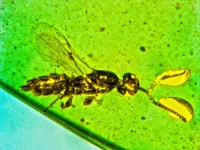(Press-News.org) A new study conducted by researchers at The University of Texas MD Anderson Cancer Center suggests that enhanced infection prevention and control (IPC) measures implemented to address the COVID-19 pandemic contributed to a significant decrease in many healthcare-associated infections (HAIs) and a reduction in respiratory viral infections (RVIs). The findings, published today in the American Journal of Infection Control (AJIC), provide some of the first evidence that strict pandemic-related IPC interventions reduced HAI rates among vulnerable patient populations.
“Previous, large-scale studies revealed an alarming increase in some HAIs during the pandemic, which may be partly attributed to the necessary, dramatic shift in institutional IPC priorities,” said Roy F. Chemaly, M.D., MPH, Chair of Infectious Diseases, Infection Control, and Employee Health at MD Anderson, and the lead author on the published study. “Our findings suggest that enhanced and targeted IPC measures enabled our facility to avoid these increases and, in several cases, significantly reduce the incidence of HAIs among our patient population during the pandemic.”
Beginning in March 2020, M.D. Anderson deployed enhanced IPC practices to reduce the spread of SARS-CoV-2, including high-level personal protective equipment, universal masking, enhanced environmental disinfection, and visitor restrictions, among others.
Dr. Chemaly and colleagues calculated the incidence rates (IRs) of six HAIs among the approximately 30,000 patients admitted annually at the cancer center from September 2016 through March 2022: C. difficile infection (C. diff), multidrug-resistant organisms (MDROs), respiratory viral infections (RVIs) and three device-related infections -- catheter-associated urinary tract infections (CAUTI), central line-associated bloodstream infections (CLABSI), and ventilator-associated events (VAE). The researchers then compared IRs for all HAIs for the 42 months prior to the pandemic (September 2016-February 2020) and the 25 months after the pandemic onset (March 2020-March 2022), as well as during the time of COVID-19 surges and in COVID-19-designated wards at the 767-bed facility.
Results show that the incidences of laboratory-identified C. diff (Li-CDI), CLABSI, and total RVIs at MD Anderson decreased significantly since the start of the COVID-19 pandemic. Rates of MDROs were unchanged except among patients on COVID-19 wards, and rates of other device-related infections remained stable. Specifically:
The incidence of Li-CDI significantly decreased after the onset of the pandemic, from 6.58 cases per 10,000 patient days to 4.31, with a statistically significant incidence rate ratio (IRR) of 0.65. The Li-CDI rates were similar between surge and non-surge periods (0.43 during surge vs. 0.44 during non-surge periods).
The total IR of nosocomial RVIs significantly decreased from the pre-pandemic to the pandemic period, from 5.24 to 1.90 per 1,000 admissions, with an IRR of 0.36. The IR did not change significantly between surge and non-surge periods. When evaluated individually, the IRs of SARS-CoV-2 and nosocomial respiratory syncytial virus (RSV) infections were significantly higher during the surge period, while the IR of nosocomial influenza infection was comparatively lower.
The overall IRs of nosocomial MDROs were similar from the pre-pandemic to the pandemic period (0.66-0.74 with an IRR of 1.22) and did not significantly change between surge and non-surge periods (0.16 vs. 0.14). Notably, the overall IR of MDROs in the COVID-19 wards was more than five times higher than in the other inpatient wards (1.99 vs. 0.35 with an IRR of 5.77).
The rate of CLABSI significantly decreased during the pandemic, from 0.51 to 0.32 per 1,000 catheter days (IRR of 0.63). Notably, MD Anderson recorded 100% CLABSI bundle compliance in September 2022, with central line placement and maintenance completed exclusively by trained and experienced staff.
The rates of CAUTI (0.75-0.66; IRR of 0.88) and VAE (3.10-1.82; IRR 0.60) did not significantly change between the pre-pandemic and pandemic periods.
“The encouraging findings from this study suggest that prioritizing and investing in evidence-based IPC practices can reduce HAIs, even among particularly vulnerable populations during extreme situations such as the COVID-19 pandemic,” said Patricia Jackson, RN, BSN, MA, CIC, FAPIC, 2023 APIC president.
About APIC
Founded in 1972, the Association for Professionals in Infection Control and Epidemiology (APIC) is the leading association for infection preventionists and epidemiologists. With more than 15,000 members, APIC advances the science and practice of infection prevention and control. APIC carries out its mission through research, advocacy, and patient safety; education, credentialing, and certification; and fostering development of the infection prevention and control workforce of the future. Together with our members and partners, we are working toward a safer world through the prevention of infection. Join us and learn more at apic.org.
About AJIC
As the official peer-reviewed journal of APIC, The American Journal of Infection Control (AJIC) is the foremost resource on infection control, epidemiology, infectious diseases, quality management, occupational health, and disease prevention. Published by Elsevier, AJIC also publishes infection control guidelines from APIC and the CDC. AJIC is included in Index Medicus and CINAHL. Visit AJIC at ajicjournal.org.
NOTE FOR EDITORS
“The impact of the COVID-19 pandemic on hospital-acquired infections at a comprehensive cancer center,” by Rita Wilson Dib, MD; Amy Spallone, MD; Fareed Khawaja, MBBS; Adina Feldman, MPH; Sherry Cantu, MPH; and Roy F. Chemaly, MD, MPH, was published online in AJIC on October 5, 2023. The article may be found at: https://doi.org/10.1016/j.ajic.2023.08.019.
AUTHORS
Roy F. Chemaly, MD, MPH (corresponding author: rfchemaly@mdanderson.org)
The University of Texas MD Anderson Cancer Center, Houston, Texas, USA
Rita Wilson Dib, MD, The University of Texas MD Anderson Cancer Center and The University of Texas Health Science Center at Houston, Houston, Texas, USA
Amy Spallone, MD, The University of Texas MD Anderson Cancer Center, Houston, Texas, USA
Fareed Khawaja, MBBS, The University of Texas MD Anderson Cancer Center, Houston, Texas, USA
Adina Feldman, MPH, The University of Texas MD Anderson Cancer Center, Houston, Texas, USA
Sherry Cantu, MPH, The University of Texas MD Anderson Cancer Center, Houston, Texas, USA
# # #
END
Study shows enhanced pandemic-related infection prevention and control practices reduced incidence of healthcare-associated infections
Findings published today in AJIC
2023-10-05
ELSE PRESS RELEASES FROM THIS DATE:
New study reveals Australian Long COVID response lagging
2023-10-05
New research by RMIT University and Northern Health has examined Australia’s Long COVID services, guidelines and public health information, compared with international standards.
The researchers found Australia lacking in several categories, including early investigation, accessibility and availability of trustworthy public health information, and adequate multidisciplinary Long COVID services to meet demand.
Dean of RMIT’s School of Health and Biomedical Sciences and co-author on the paper, Professor Catherine Itsiopoulos, warned that this problem will only worsen over time.
“Long ...
Vaccine via the nasal passage could be the new line of defence against Strep A
2023-10-05
As Streptococcus A cases continue to be prevalent in Queensland and internationally, a new nasal vaccine could provide long-term protection from the deadly bacteria.
Associate Professor Manisha Pandey, Professor Michael Good, and their team from Griffith University’s Institute for Glycomics, are leading the development of a Strep A vaccine which is currently in Phase 1 clinical trials in Canada and quickly advancing to Phase 2 efficacy trials.
The team’s new preclinical research, recently published in Nature Communications, shows an experimental liposome-based vaccine approach incorporating a conserved M-protein epitope from Strep A and an immunostimulatory glycolipid (3D(6-acyl) ...
Mays Cancer Center at UT Health San Antonio identifies possible markers for early metastatic lung cancer
2023-10-05
SAN ANTONIO, Oct. 5, 2023 – Researchers at Mays Cancer Center at The University of Texas Health Science at San Antonio (UT Health San Antonio) have identified protein markers that could signal for early development of metastatic lung cancer, providing possibilities for new treatment.
The findings already have led to a five-year, $1.6 million grant from the National Cancer Institute of the National Institutes of Health that will pave the way for a clinical trial next year for patients with advanced lung cancer. The research is detailed in a new article in Cell Reports, ...
WHO director praises London’s ULEZ expansion as politically courageous
2023-10-05
London mayor Sadiq Khan’s efforts to expand the capital’s Ultra Low Emission Zone (ULEZ) as part of a push to reduce air pollution and improve health, is politically courageous and an example for mayors around the world, says the World Health Organization’s environment, climate change and health director, Maria Neira.
In an exclusive interview for The BMJ’s climate issue, Neira says she is tired of listening to politicians speak on climate change as if they didn't have the power to ...
Software can detect hidden and complex emotions in parents
2023-10-05
Researchers have conducted trials using a software capable of detecting intricate details of emotions that remain hidden to the human eye.
The software, which uses an ‘artificial net’ to map key features of the face, can evaluate the intensities of multiple different facial expressions simultaneously.
The University of Bristol and Manchester Metropolitan University team worked with Bristol’s Children of the 90s study participants to see how well computational methods could capture authentic human emotions amidst everyday ...
$2 million grant boosts technological advancements in cutting-edge cell therapy manufacturing facility
2023-10-05
The Keck School of Medicine of USC has received $2 million from the California Institute of Regenerative Medicine (CIRM) to further augment its newly launched cGMP Laboratory, a state-of-the-art facility designed to advance early-stage research into clinically viable cell and gene therapies. To expedite the translation of these therapies from the lab to the clinic, the facility needs advanced technological know-how, streamlined operations and strict protocols for developing and testing these products, all of which ...
Texas Children’s Bariatric Surgery Program receives prestigious national accreditation
2023-10-05
HOUSTON (October 4, 2023) – Texas Children’s Hospital is proud to announce that its Adolescent Bariatric Surgery Program has received national accreditation from the Metabolic and Bariatric Surgery Accreditation and Quality Improvement Program (MBSAQIP).
Texas Children’s Hospital The Woodlands is the only Bariatric Surgery Center in the state of Texas that serves to an adolescent-only patient population with a multidisciplinary clinical staff who is certified to meet the surgical, medical and psychological needs of ...
Two-dimensional compounds can capture carbon from the air
2023-10-05
Some of the thinnest materials known to mankind may provide solutions to scientists in their quest to curb the effects of global warming.
Known as MXene and MBene compounds, these substances are only a few atoms thick, making them two-dimensional. Because of their large surface area, the materials have the potential to absorb carbon dioxide molecules from the atmosphere, which could help reduce the harmful effects of climate change by safely sequestering carbon dioxide.
In a paper published Oct. 4 in the journal Chem, UC Riverside professor Mihri Ozkan and her co-authors explain the potential of MXenes and MBenes in carbon capture technologies.
“In this review, ...
New type of tiny wasp comes with mysterious, cloud-like structures at ends of antennae
2023-10-05
CORVALLIS, Ore. – Fossil researchers have discovered a novel genus and species of tiny wasp with a mysterious, bulbous structure at the end of each antenna.
The female micro-wasp was described from 100-million-year-old Burmese amber in a study led by George Poinar Jr., who holds a courtesy appointment in the Oregon State University College of Science.
Poinar and Fernando Vega, an independent researcher based in Silver Spring, Maryland, have some ideas about the “clouds” on the ...
Tirzepatide is as effective at treating early-onset type 2 diabetes as diabetes diagnosed later in life
2023-10-05
Tirzepatide is as effective at treating early-onset type 2 diabetes (T2D), a more aggressive form of the condition that normally responds less well to treatment, as it is at treating T2D diagnosed later in life, new research being presented at the Annual Meeting of the European Association for the Study of Diabetes (EASD) in Hamburg, Germany (2-6 Oct) has found.
Tirzepatide belongs to a new class of drugs that mimic the effect of two hormones involved in blood sugar control and appetite suppression, ...
LAST 30 PRESS RELEASES:
New research confirms people with ME/CFS have a consistent faulty cellular structure
Hidden cancer risk behind fatty liver disease targets
Born in brightness, leading to darkness
Boron-containing Z-type and bilayer benzoxene
Hong Kong researchers break the single-field barrier with dual-field assisted diamond cutting
Work hard, play hard?
Wood becomes smart glass: Photo- and electro-chromic membrane switches tint in seconds
The Lancet: COVID-19 vaccine hesitancy decreased over time, though mistrust persists among certain groups, study of over 1 million people in England suggests
Psychosis patients ‘living in metaphor’ -- new study radically shifts ideas about delusions
Clinical trial in Ethiopia targets the trachoma scourge
Open-sourcing the future of food
Changes in genetic structure of yeast lead to disease-causing genomic instabilities
UC San Diego Health Sciences Grant Writing Course helps launch successful research careers
Study: Many head and neck cancer trials end early. Why?
Tufts vice provost for research named Foreign Fellow of Indian National Science Academy
New model improves prediction of prostate cancer death risk
Two wrongs make a right: how two damaging variants can restore health
Overlooked decline in grazing livestock brings risks and opportunities
Using rare sugars to address alcoholism
Research alert: New vulnerability identified in aggressive breast cancer
Ruth Harris honored with SSA Distinguished Service Award
Treasure trove of data on aging publicly accessible
Trees4Adapt project to address risks from climate change and biodiversity loss through tree-based solutions
Nature Communications study from the Lundquist Institute identifies molecular mechanism underlying peripartum cardiomyopathy
Pennington Biomedical’s Dr. Gang Hu appointed to NIH Reproductive, Perinatal and Pediatric Health Review Group
World-first project shows great promise to treat low eye pressure
New technique puts rendered fabric in the best light
Brain cancer digital twin predicts treatment outcomes
Cat disease challenges what scientists thought about coronaviruses
Paulson Family Foundation makes an additional $19 million donation to Hebrew University to fund a new building for electrical engineering. Together with its previous gift brings the total donation to
[Press-News.org] Study shows enhanced pandemic-related infection prevention and control practices reduced incidence of healthcare-associated infectionsFindings published today in AJIC



